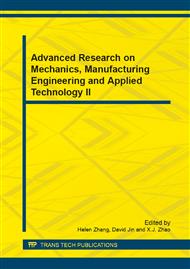[1]
Y.M. Deng and Edwards K.L. The role of materials identification and selection in engineering design. Materials & Design Vol. 28 (2007), pp.31-39.
Google Scholar
[2]
A. Jahan, M. Bahraminasab and K.L. Edwards . A target-based normalization technique for materials selection. Materials & Design Vol. 35 (2012), pp.647-654.
DOI: 10.1016/j.matdes.2011.09.005
Google Scholar
[3]
H.C. Liu, L. Liu and J. Wu. Material selection using an interval 2-tuple linguistic VIKOR method considering subjective and objective weights. Materials & Design Vol. 52 (2013), pp.158-167.
DOI: 10.1016/j.matdes.2013.05.054
Google Scholar
[4]
P. Chatterjee , V. M. Athawale and S. Chakraborty. Selection of materials using compromise ranking and outranking methods. Materials and Design Vol. 30 (2009), p.4043–4053.
DOI: 10.1016/j.matdes.2009.05.016
Google Scholar
[5]
A. Jahan, M. Y. Ismail , F. Mustapha and S. M. Sapuan. Material selection based on ordinal data. Materials and Design Vol. 31 (2010), pp.3180-3187.
DOI: 10.1016/j.matdes.2010.02.024
Google Scholar
[6]
A. Shanian and O. Savadogo. A material selection model based on the concept of multiple attribute decision making. Materials and Design Vol. 27 (2006), pp.329-337.
DOI: 10.1016/j.matdes.2004.10.027
Google Scholar
[7]
A. Shanian and O. Savadogo. TOPSIS multiple-criteria decision support analysis for material selection of metallic bipolar plates for polymer electrolyte fuel cell. J. Power Sources Vol. 159 (2006) pp.1095-1104.
DOI: 10.1016/j.jpowsour.2005.12.092
Google Scholar
[8]
K. Maniya and M.G. Bhatt. A selection of material using a novel type decisionmaking method: preference selection index method. Materials and Design Vol. 31 (2010), pp.1785-1789.
DOI: 10.1016/j.matdes.2009.11.020
Google Scholar
[9]
P. Chatterjee, V.M. Athawale and S. Chakraborty. Materials selection using complex proportional assessment and evaluation of mixed data methods. Materials and Design vol. 32 (2011), pp.851-860.
DOI: 10.1016/j.matdes.2010.07.010
Google Scholar
[10]
R.V. Rao. Decision making methodology for material selection using an improved compromise ranking method. Materials and Design Vol. 29 (2008), p.1949-(1954).
DOI: 10.1016/j.matdes.2008.04.019
Google Scholar
[11]
R. J. Girubha and S. Vinodh . Application of fuzzy VIKOR and environmental impact analysis for material selection of an automotive component. Materials & Design, Vol. 37 (2012), P. 478-486.
DOI: 10.1016/j.matdes.2012.01.022
Google Scholar
[12]
A. Kasaei, A. Abedian and A.S. Milani . An application of Quality Function Deployment method in engineering materials selection. Materials & Design, Vol. 55 (2014), pp.912-920.
DOI: 10.1016/j.matdes.2013.10.061
Google Scholar
[13]
B.H. Men and C. Liang. Attribute recognition model-based variation coefficient weight for evaluating water quality, Journal of Harbin Institute of Technology, Vol. 37 (2005), pp.1373-1375.
Google Scholar
[14]
A. Jahan, F. Mustapha, S.M. Sapuan, M.Y. Ismail, and M. Bahraminasab. A framework for weighting of criteria in ranking stage of material selection process. Int J Adv Manuf Technol. Vol. 58 (2012), p.411–420.
DOI: 10.1007/s00170-011-3366-7
Google Scholar
[15]
M. Farag Materials selection for engineering design (Prentice-Hall, New York, 1997).
Google Scholar


